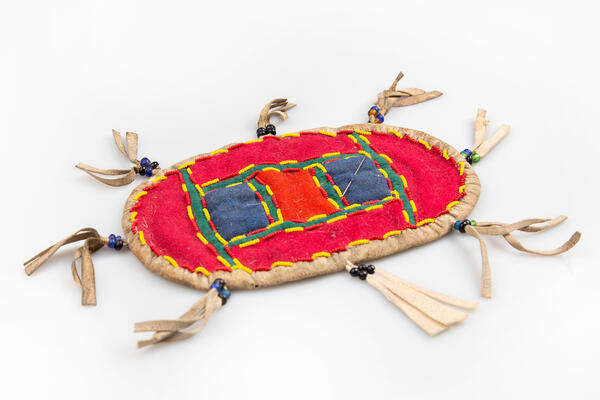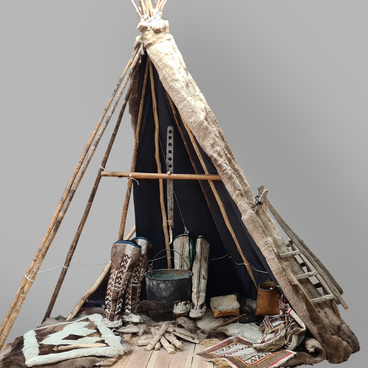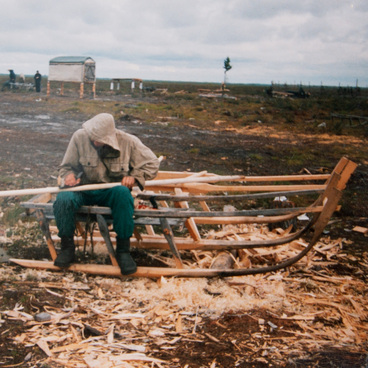Sewing national costumes and household items plays a crucial role in the traditional culture of the peoples of the North. At a very early age girls get acquainted with different types of sewing techniques and learn from their grandmothers and mothers. At the age of seven, a girl gets her own bag for sewing supplies — it is called a tutchan. When she gets married, the girl takes a handmade bag and a needle case with her. If a young wife does not have a tutchan, then she left her parent’s home against her will.
Pincushions are sewn from colored cloth, chintz and satin — the fabric was always bright. Craftswomen do not throw the bits and pieces away but use them to make small embroideries. A pincushion was sewn and given not for beauty, but for practical use and as a talisman for the lady of the house.
The oval pincushion from the exhibition of the Purovsky Museum belonged to a needlewoman of the Khanty people. It is made of red-colored cloth and trimmed with rawhide and tassels. In the center, there is a band of cloth in contrasting colors — it forms the working surface of the pincushion, which is called the “eye” or “heart”.
The inner edge of the rawhide and cloth ornaments are decorated with a beaded thread in a yellow-red color scheme. For the reverse side of the pincushion, needlewomen traditionally use thin abdominal deer skin called “khon nyur”. They also use curly fur from the back of an old fur coat, cloth, rawhide, tarpaulin or artificial leather. The entire surface is stitched with small stitches, similar to traces — “deer steps”. The seam on the front is barely noticeable, and on the back the large lines of stitches go round or across the pincushion. It is believed that “the more stitches there are, the more deer the craftswoman will have.”
When the pincushion is not used, it is folded like an envelope and tied with a rawhide strap. Khanty women try not to show their pincushions because they are afraid that their skills will be jinxed. People of traditional culture attach special importance to the storage of a needle: this is the main tool of a woman. In addition to the utilitarian function, the needle is also a symbol of the femininity.
Pincushions are sewn from colored cloth, chintz and satin — the fabric was always bright. Craftswomen do not throw the bits and pieces away but use them to make small embroideries. A pincushion was sewn and given not for beauty, but for practical use and as a talisman for the lady of the house.
The oval pincushion from the exhibition of the Purovsky Museum belonged to a needlewoman of the Khanty people. It is made of red-colored cloth and trimmed with rawhide and tassels. In the center, there is a band of cloth in contrasting colors — it forms the working surface of the pincushion, which is called the “eye” or “heart”.
The inner edge of the rawhide and cloth ornaments are decorated with a beaded thread in a yellow-red color scheme. For the reverse side of the pincushion, needlewomen traditionally use thin abdominal deer skin called “khon nyur”. They also use curly fur from the back of an old fur coat, cloth, rawhide, tarpaulin or artificial leather. The entire surface is stitched with small stitches, similar to traces — “deer steps”. The seam on the front is barely noticeable, and on the back the large lines of stitches go round or across the pincushion. It is believed that “the more stitches there are, the more deer the craftswoman will have.”
When the pincushion is not used, it is folded like an envelope and tied with a rawhide strap. Khanty women try not to show their pincushions because they are afraid that their skills will be jinxed. People of traditional culture attach special importance to the storage of a needle: this is the main tool of a woman. In addition to the utilitarian function, the needle is also a symbol of the femininity.




